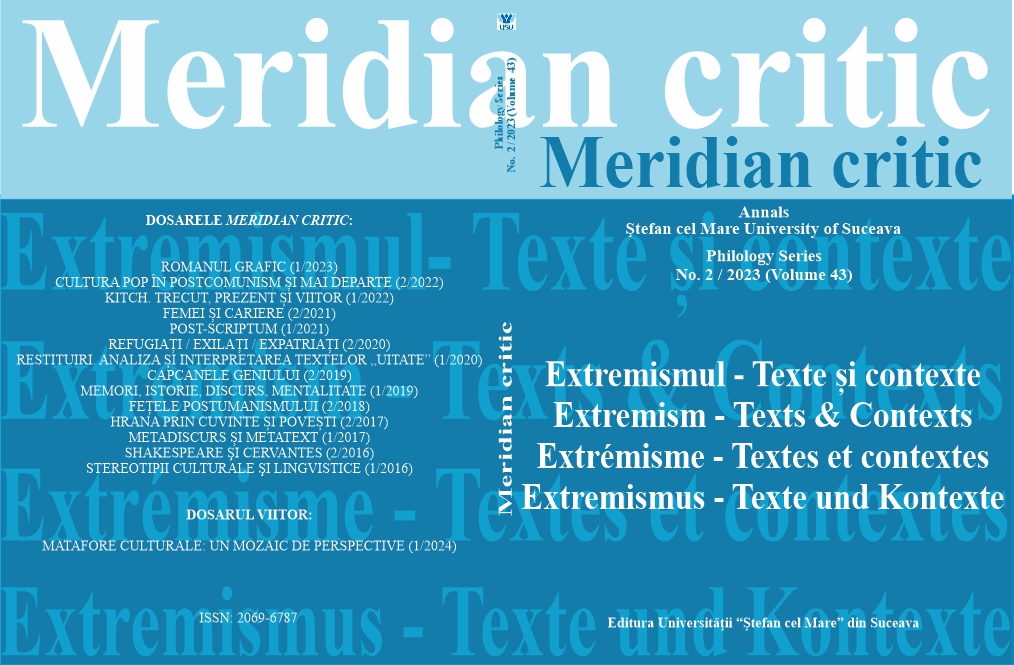O perspectivă asupra conştiinţei idealului în gândirea artistică şi filosofică
A Perspective on the Consciousness of the Ideal in Artistic and Philosophical Thought
Author(s): Mariana Baloșescu, Porfirie PescaruSubject(s): Language and Literature Studies, Studies of Literature, Sociology, Sociology of Literature
Published by: UNIVERSITATEA »ȘTEFAN CEL MARE« SUCEAVA
Keywords: ideal; arts; concience; cultural model; ancient culture; modernity; posthuman
Summary/Abstract: The academic discourse of criticism and theory of literature and arts has been promoting in recent years with great insistence quantitative computational analyses, based on the interposition between reader consciousness and textual consciousness of artificial intelligence. The current article, named after Franco Moretti’s distant reading, clearly indicates an alienation, through effective distancing, from the text read, which produces several direct consequences.The concepts of person and ideal, consciousness, personal consciousness and consciousness of the ideal – in the sense of major landmarks for the appreciation and interpretation of the text read – are deliberately marginalized or excluded from the discussion. Talking about the ideal is an action as reckless as it is necessary in our world. Through ideological-social discourse, legitimised and fed by the discourse of science and philosophy, modern man is driven towards a definitive alienation from his natural need for the ideal. Inherited teachings about the ideal are also quickly abandoned. On the other hand, art reflects realities and often anticipates them. In this essay, we would like to show that a simple analytical survey of the backbone of the representation of the ideal in artistic thought, seen in its historical consanguinity with philosophical and theological thought, reveals an unsettling dynamic of the vision of the ideal. Modern philosophical consciousness, especially after Kant and then Nietzsche, and the ideologies it has generated, are changing the original figure of the ideal to such an extent that today it is unrecognisable. Man is driven outside his own nature, but also outside the memory of the historical civilisations he has built. The perception conveyed by writers, artists and philosophers, especially after 1850, is that of a loss of the ideal. Unsurprisingly, this negative energy has given rise to an entire culture of the crisis of modernity which, without addressing the causes of the crisis, amplifies the crisis, justifies it and gives it, especially in the 20th century, an expansion which today breaks Western societies away from the claimed civilisational models: the Christian-Jewish model and the Greco-Latin model. What we propose is to point out a few more significant fragments of a very broad debate. And, finally, the analysis sends the reader towards the spiritual and discursive presence of solutions to the crisis of the ideal in the (apparently) anarchic combustion of our strictly contemporary culture. Posthumanists talk about the human species, and not about man, person, consciousness. They undifferentiatedly call all previous history traditional humanity and claim to leave it by so-called overcoming the conventional limits of human existence and traditional biological constraints. Post-humanist discourse calls for the abrupt redefinition of the human to justify the improvement of the 'human species' through technology. In fact, posthumanism reduces man to biology, matter and corporeality in order to legitimize the massification of people and their expropriation of their inherited civilizational memory, but above all of their own consciousness and their original need to live within the horizon of an ideal. The return to the consciousness of the ideal in artistic and philosophical thought is today more than a natural reaction to posthumanist ideological aggression. It is both a way of knowing inherited culture and a foundation for the culture of the present.
Journal: Meridian critic
- Issue Year: XLIII/2023
- Issue No: 2
- Page Range: 137-150
- Page Count: 14
- Language: Romanian

